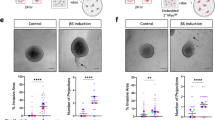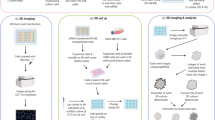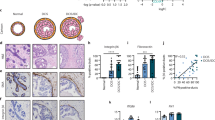Abstract
Human myoepithelial cells which surround ducts and acini of certain organs such as the breast form a natural border separating epithelial cells from stromal angiogenesis. Myoepithelial cell lines (HMS-1-6), derived from diverse benign myoepithelial tumors, all constitutively express high levels of active angiogenic inhibitors which include TIMP-1, thrombospondin-1 and soluble bFGF receptors but very low levels of angiogenic factors. These myoepithelial cell lines inhibit endothelial cell chemotaxis and proliferation. These myoepithelial cell lines sense hypoxia, respond to low O2 tension by increased HIF-1α but with only a minimal increase in VEGF and iNOS steady state mRNA levels. Their corresponding xenografts (HMS-X-6X) grow very slowly compared to their non-myoepithelial carcinomatous counterparts and accumulate an abundant extracellular matrix devoid of angiogenesis but containing bound angiogenic inhibitors. These myoepithelial xenografts exhibit only minimal hypoxia but extensive necrosis in comparison to their non-myoepithelial xenograft counterparts. These former xenografts inhibit local and systemic tumor-induced angiogenesis and metastasis presumably from their matrix-bound and released circulating angiogenic inhibitors. These observations collectively support the hypothesis that the human myoepithelial cell (even when transformed) is a natural suppressor of angiogenesis.
This is a preview of subscription content, access via your institution
Access options
Subscribe to this journal
Receive 50 print issues and online access
$259.00 per year
only $5.18 per issue
Buy this article
- Purchase on Springer Link
- Instant access to full article PDF
Prices may be subject to local taxes which are calculated during checkout





Similar content being viewed by others
Abbreviations
- UVE:
-
human umbilical vein endothelial cells
- CM:
-
conditioned medium
- FCS:
-
fetal calf serum
- DCIS:
-
ductal carcinoma in situ
- TIMP-1:
-
tissue inhibitor of metalloproteinase-1
- HMEC:
-
human mammary epithelial cells
- K-SFM:
-
keratinocyte serum-free medium
- vWf:
-
von Willebrand factor
- PMA:
-
phorbol 12-myristate 13-acetate
- bFGF:
-
basic fibroblast growth factor
- aFGF:
-
acidic fibroblast growth factor
- TFGα:
-
transforming growth factor α
- TGFβ:
-
transforming growth factor β
- TNFα:
-
tumor necrosis factor α
- VEGF:
-
vascular endothelial growth factor
- PD-ECGF:
-
platelet-derived endothelial cell growth factor
- PlGF:
-
placental growth factor
- IFα:
-
interferon α
- HGF:
-
hepatocyte growth factor
- HB-EGF:
-
heparin-binding endothelial growth factor
- PF4:
-
platelet factor 4
- and iNOS:
-
inducible nitric oxide synthase
- HIF-1α:
-
hypoxia inducible factor-1α
- HRE:
-
hypoxia response element
References
Alpaugh ML, Tomlinson JS, Shao ZM and Barsky SH. . 1999 Cancer Res. 59: 5079–5084.
Bagavandoss P and Wilkes JW. . 1990 Biochem. Biophys. Res. Commun. 170: 867–872.
Cavenee WK. . 1993 J. Clin. Invest. 91: 3.
Clapp C, Martial JA, Guzman RC, Rentier-Delrue F and Weiner RI. . 1993 Endocrinology 133: 1292–1299.
Cornil I, Theodorescu D, Man S, Herlyn M, Jambrosic J and Kerbel RS. . 1991 Proc. Natl. Acad. Sci. USA 88: 6028–6032.
Dawson DW, Pearce SFA, Zhong R, Silverstein RL, Frazier WA and Bouck NP. . 1997 J. Cell Biol. 138: 707–717.
Folkman J. . 1990 J. Natl. Cancer Inst. 82: 1–3.
Folkman J. . 1995a N. Engl. J. Med. 333: 1757–1763.
Folkman J. . 1995b The Molecular Basis of Cancer, ed. Mendelsohn J, Howley PM, Israel MA and Liotta LA . pp. 206–232.
Folkman J and Klagsbrun M. . 1987 Science 235: 442–447.
Fridman R, Kibbey MC, Royce LS, Zain M, Sweeney TM, Jicha DL, Yannelli JR, Martin GR and Kleinman HK. . 1991 J. Natl. Cancer Inst. 83: 769–774.
Hanahan D and Folkman J. . 1996 Cell 86: 353–364.
Langone JJ. . 1982 Adv Immunol. 32: 157–252.
Liotta LA, Steeg PS and Stetler-Stevenson WG. . 1991 Cell 64: 327–336.
Namiki A, Brogi E, Kearney M, Kim EA, Wu T, Couffinhal T, Varticovski L and Isner JM. . 1995 J. Biol. Chem. 270: 31189–31195.
Nguyen M, Strubel NA and Bischoff J. . 1993 Nature 365: 267–269.
O'Reilly MS, Boehm T, Shing Y, Fukai N, Vasios G, Lane WS, Flynn E, Birkhead JR, Olsen BR and Folkman J. . 1997 Cell 88: 277–285.
O'Reilly MS, Holmgren L, Shing Y, Chen C, Rosenthal RA, Moses M, Lane WS, Cao Y, Sage EH and Folkman J. . 1994 Cell 79: 315–328.
O'Reilly MS, Pirie-Shepherd S, Lane WS and Folkman J. . 1999 Science 285: 1926–1928.
Safarians S, Sternlicht MD, Freiman CJ, Huaman JA and Barsky SH. . 1996 Int. J. Cancer 66: 151–158.
Shao ZM, Nguyen M, Alpaugh ML, O'Connell JT and Barsky SH. . 1998 Exp. Cell Res. 241: 394–403.
Sternlicht MD, Kedeshian P, Shao ZM, Safarians S and Barsky SH. . 1997 Clin. Cancer Res. 3: 1949–1958.
Sternlicht MD, Safarians S, Calcaterra TC and Barsky SH. . 1996b In Vitro Cell. Dev. Biol. 32: 550–563.
Sternlicht MD, Safarians S, Rivera SP and Barsky SH. . 1996a Lab. Invest. 74: 781–796.
Tobacman JK. . 1997 Cancer Res. 57: 2823–2826.
Varia MA, Calkins-Adams DP, Rinker LH, Kennedy AS, Novotny DB, Fowler WC and Raleigh JA. . 1998 Gynecol. Oncol. 71: 270–277.
Weidner N, Semple JP, Welch WR and Folkman J. . 1991 N. Engl. J. Med. 324: 1–8.
Weinstat-Saslow DL, Zabrenetzky VS, VanHoutte K, Frazier WA, Roberts DD and Steeg PS. . 1994 Cancer Res. 54: 6504–6511.
Xiao G, Liu YE, Gentz R, Sang QA, Ni J, Goldberg ID and Shi YE. . 1999 Proc. Natl. Acad. Sci. USA 96: 3700–3705.
Zhang M, Volpert O, Shi YH and Bouck N. . 2000 Nature Med. 6: 196–199.
Zou Z, Anisowicz A, Hendrix MJC, Thor A, Neveu M, Sheng S, Rafidid K, Seftor E and Sager R. . 1994 Science 263: 526–529.
Acknowledgements
This work was supported by USPHS grants CA71195, CA83111, the California Research Co-Ordinating Committee and the Department of Defense grant BC 990959.
Author information
Authors and Affiliations
Rights and permissions
About this article
Cite this article
Nguyen, M., Lee, M., Wang, J. et al. The human myoepithelial cell displays a multifaceted anti-angiogenic phenotype. Oncogene 19, 3449–3459 (2000). https://doi.org/10.1038/sj.onc.1203677
Received:
Revised:
Accepted:
Published:
Issue Date:
DOI: https://doi.org/10.1038/sj.onc.1203677
Keywords
This article is cited by
-
Re-evaluation of the myoepithelial cells roles in the breast cancer progression
Cancer Cell International (2022)
-
Mechanostimulation of breast myoepithelial cells induces functional changes associated with DCIS progression to invasion
npj Breast Cancer (2022)
-
Loss of amphiregulin reduces myoepithelial cell coverage of mammary ducts and alters breast tumor growth
Breast Cancer Research (2018)
-
Breaking through to the Other Side: Microenvironment Contributions to DCIS Initiation and Progression
Journal of Mammary Gland Biology and Neoplasia (2018)
-
Quantitative diagnosis of breast tumors by morphometric classification of microenvironmental myoepithelial cells using a machine learning approach
Scientific Reports (2017)



